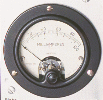Physics 340
Audio Engineering
Review Sheet For Exam #1:
Some of the things you should know for the first
exam:
Human Hearing, the Fletcher Munson Effect, and the Decibel Scale:
The Simple Harmonic Oscillator:
- Requires a linear restoring force - Hooke's Law
- Be able to derive the equation of motion and solve it for the simple
harmonic oscillator
- Vibration at a single frequency
- Know (and be able to derive and use) the relationship between k, m, and the
angular frequency
- Total energy is proportional to the square of the amplitude
- Maximum kinetic energy = total energy
- Maximum kinetic energy is proportional to the square of the amplitude
- Be able to derive the equation for the driven harmonic oscillator
- Be able to derive the amplitude as a function of frequency for the simple
harmonic oscillator
- Understand resonance in the simple harmonic oscillator
Coupled Oscillators and Normal Modes:
- In most actual physical situations an oscillator is not isolated, but
rather interacts with nearby oscillators (is coupled)
- You should be able to write down free body diagrams and apply Newton's laws
for combinations of springs, masses, and pendulums and obtain the differential
equations of motion.
- Be able to solve the equations by addition, subtraction etc. and find the
normal mode frequencies and amplitude ratios
- Be able to use the general analytical approach to find normal mode
frequencies and amplitude ratios
- In a normal mode, all particles oscillate with the same frequency and a
constant amplitude.
- Any motion of a coupled oscillator can be viewed as linear combinations of
the normal mode oscillations.
- The number of normal modes of oscillation of a linear system is equal to
the number of particles. For a more general system it is equal to the number of
coordinates needed to fully describe the system (i.e. the number of degrees of
freedom.)
- For n coupled particles, be able to use/interpret the equations for the
amplitudes and frequencies that I would provide. Perhaps an essay question on
these equations?
- Be able to take the limit of the previously mentioned equations as the
number of particles becomes very large.
- One can define normal coordinates (which are linear combinations of
ordinary coordinates) for the system (one normal coordinate per degree of
freedom)
- If the normal mode oscillations are close together in frequency we observe
the classical "beating" pattern
- Be able to show that in a forced coupled system a large response occurs at
the normal mode frequencies. (Resonance)
Continuous Systems, The Wave Equation, and Fourier Analysis:
- Be familiar with the wave equation
- Be able to prove that a function I provide is a solution to the wave
equation
- Understand the normal modes and frequencies of a continuous string
- Line
- The period of the lowest mode is the time it takes a pulse to travel down
and back once along the string
- Any periodic vibration of the string is a superposition of normal modes
- Leads to concept of Fourier analysis
- Understand the simple complex analysis that we did and be able to use it
- Concept of orthogonal functions
- Be able to show that two functions are orthogonal on some interval
- Understand "Fourier's Trick"
- Know the expressions for the Fourier coefficients on symmetric intervals
and be able to use them to find the Fourier coefficients for simple periodic
functions
- Understand the theory of even and odd functions

- The integral of any odd function over a symmetrical interval is always
zero

Questions, Comments, and E-Mail
 If you have any questions or
comments, you can send E-Mail to Dr. Greg Latta at
glatta@frostburg.edu
If you have any questions or
comments, you can send E-Mail to Dr. Greg Latta at
glatta@frostburg.edu
This page is under constant revision. Please check back often.
Thanks for stopping by!
 Back to the Physics
340 Audio Engineering Page
Back to the Physics
340 Audio Engineering Page  Back to Dr. Greg Latta's Electrical
Engineering and Amateur Radio Pages
Back to Dr. Greg Latta's Electrical
Engineering and Amateur Radio Pages  If you have any questions or
comments, you can send E-Mail to Dr. Greg Latta at
glatta@frostburg.edu
If you have any questions or
comments, you can send E-Mail to Dr. Greg Latta at
glatta@frostburg.edu